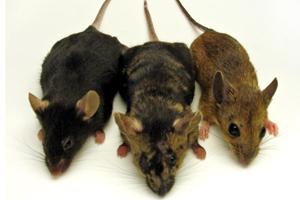Scientists merge mammalian cells from two species, creating chimera
By Catherine GianaroMedical Center Communications
 | |
By injecting embryonic stem cells from a wood mouse into the early embryo of a house mouse, an international team of scientists has produced normal, healthy animals made up of a mixture of cells from each of the two distantly related species. This is the first time that stem cells from one mammalian species have been shown to contribute extensively to development when introduced into the embryo of another, very different species.
Featured on the cover of the Jan. 1 issue of the journal Human Molecular Genetics, scientists from the University, Sun Yat-sen University, China, and the University of Liverpool, U.K., describe how they produced a viable “chimera” — a single organism with two distinct populations of cells from two different sources.
Although both are rodents, the wood mouse (Apodemus sylvaticus) and the house mouse (Mus musculus) have evolved separately for up to 20 million years. Their genes differ by as much as 18 percent, about 12 times the difference between humans and chimpanzee.
Scientists had previously used embryonic stem cells to make chimeras within the same species. “There are surprisingly high degrees of conservation in developmental programs between at least some distantly related mammalian species,” said Bruce Lahn, a Howard Hughes Medical Institute Investigator and Professor in Human Genetics at the University. “When early embryonic cells from two divergent species are mixed together, they can communicate with each other properly and develop into one seamless, functional organism.”
“These results demonstrate the feasibility of differentiating ES cells into a wide range of cell types in vivo by introducing them into an evolutionary divergent host,” the authors wrote. “This interspecies approach may be the only way to study ES cells of some species, such as human ES cells, in an in vivo context.”
The scientists extracted wood mouse embryonic stem cells and introduced a gene that produced a fluorescent protein, which enabled them to visually track the descendents of the stem cells in the chimerical organisms. They then injected about 15 wood mouse ES cells into each of 1,250 house mouse blastocysts and transferred the viable embryos into 44 surrogate house mouse mothers.
From these, 220 pups were born; 16 of them (7.3 percent) showed chimerism based on their appearance. In those 16 chimeras, up to 40 percent of the cells in some organs were wood mouse cells. These cells were integrated into all of the tissues at various levels.
The chimeras appeared healthy and had no apparent defects. They did demonstrate some behavioral differences. They were less “jumpy” than a typical wood mouse but more so than a typical, much tamer, house mouse.
Although genetically different (the wood mouse has 48 chromosomes, the house mouse, 40), both of these species have similar developmental schedules. The gestation period for a wood mouse is 23 days; the gestation time for a house mouse is 19 days. They also have approximately the same body size.
The chimeras varied in terms of how much and where the injected embryonic stem cells generated tissue. “It’s completely random where the cells will develop and grow tissue,” Lahn said, adding that more studies are planned.
“We’re going to continue with these animals for a while to see if we can understand the developmental cues and learn how to manipulate the system,” Lahn said. “For example, could injected wood mouse embryonic stem cells contribute more extensively to the liver in a house mouse that carries a genetic defect that prevents it from growing its own liver? Or, could we alter the stem cells in ways that could prevent them from contributing brain tissue?”
The researchers also plan to merge mice and rats, who have vastly different body sizes, as well as 20 percent genetic difference.
Key Scientific and Technological Projects of Guangdong Province and of Guangzhou, and the National Natural Science Foundation of China funded the project.
Other authors of the paper are: Frank Fuxiang Mao, Donghyun Park, Jaehyun Lee, Eric Vallender, Tammy Vallender and Li Zhang, of Chicago; Andy Peng Xiang, Shu-Nong Li, Wei-Qiang Li, Bao-Feng Ma, Tao Wang, Xin-Bing Yu and Xiu-Ming Zhang, of Sun Yat-sen University in Gaungzhou, China; and John Waters of the University of Liverpool, U.K.
![[Chronicle]](/images/sidebar_header_oct06.gif)